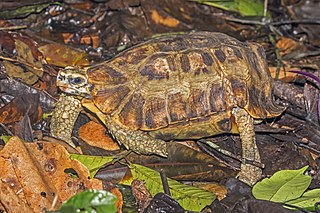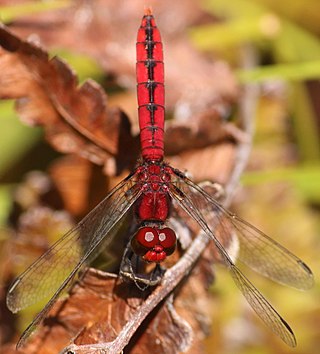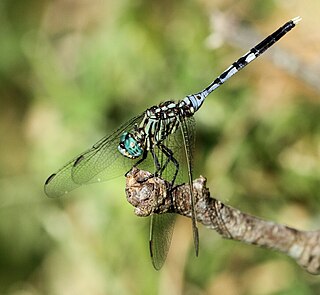The common forest tree frog is a species of frog in the family Arthroleptidae found in Angola, Cameroon, the Republic of the Congo, the Democratic Republic of the Congo, Equatorial Guinea, Gabon, Nigeria, and possibly the Central African Republic. Its natural habitats are subtropical or tropical moist lowland forest, subtropical or tropical moist montane forest, subtropical or tropical high-altitude grassland, rivers, intermittent freshwater marshes, and heavily degraded former forests.

The crowned bullfrog is a species of frog in the family Dicroglossidae. It is found in the Sub-Saharan Africa . Its natural habitats are subtropical or tropical moist lowland forest, dry savanna, moist savanna, subtropical or tropical dry shrubland, subtropical or tropical moist shrubland, subtropical or tropical dry lowland grassland, subtropical or tropical seasonally wet or flooded lowland grassland, rivers, intermittent rivers, freshwater lakes, intermittent freshwater lakes, freshwater marshes, intermittent freshwater marshes, freshwater springs, arable land, pastureland, rural gardens, heavily degraded former forest, and ponds.
The Victoria ridged frog is a species of frog in the family Ptychadenidae. It is found in Benin, Cameroon, Central African Republic, Republic of the Congo, Democratic Republic of the Congo, Ivory Coast, Equatorial Guinea, Gabon, Ghana, Guinea, Liberia, Nigeria, possibly Angola, and possibly Togo. Its natural habitats are subtropical or tropical moist lowland forest, intermittent freshwater marshes, and heavily degraded former forest. It is threatened by habitat loss.

Ptychadena oxyrhynchus, commonly known as the South African sharp-nosed frog, is a species of frog in the family Ptychadenidae. It is found in Angola, Benin, Botswana, Cameroon, Central African Republic, Chad, Republic of the Congo, Democratic Republic of the Congo, Ivory Coast, Gambia, Ghana, Guinea, Guinea-Bissau, Kenya, Malawi, Mali, Mozambique, Namibia, Nigeria, Senegal, South Africa, Swaziland, Tanzania, Togo, Uganda, Zambia, Zimbabwe, possibly Burkina Faso, possibly Burundi, possibly Niger, possibly Rwanda, and possibly Sudan.

Ptychadena pumilio is a species of frog in the family Ptychadenidae. It is found in Benin, Cameroon, Central African Republic, Democratic Republic of the Congo, Ivory Coast, Ethiopia, Mali, Nigeria, Senegal, Sierra Leone, possibly Burkina Faso, possibly Chad, possibly Gambia, possibly Ghana, possibly Guinea, possibly Guinea-Bissau, possibly Liberia, possibly Mauritania, possibly Niger, possibly Sudan, possibly Togo, and possibly Uganda. Its natural habitats are subtropical or tropical moist lowland forest, dry savanna, moist savanna, subtropical or tropical seasonally wet or flooded lowland grassland, subtropical or tropical high-altitude grassland, rivers, freshwater marshes, intermittent freshwater marshes, pastureland, rural gardens, ponds, and canals and ditches.

The blue-headed coucal is a species of cuckoo in the family Cuculidae. It is native to tropical central Africa where its typical habitat is swamps, river banks, forest edges and generally wet locations. It is a common bird with a wide range, and the International Union for Conservation of Nature has rated its conservation status as being of "least concern".

Kinixys is a genus of turtles in the family Testudinidae. The genus was erected by Thomas Bell in 1827. The species in the genus Kinixys are native to Sub-Saharan Africa and Madagascar and commonly known as hinged tortoises or hinge-back tortoises.

Home's hinge-back tortoise is a species of tortoise in the family Testudinidae. The species is endemic to Africa.

Aethriamanta rezia is a species of dragonfly in the family Libellulidae. Described by William Forsell Kirby in 1889, it is found in Angola, Botswana, the Democratic Republic of the Congo, Ivory Coast, Gambia, Ghana, Guinea, Kenya, Liberia, Madagascar, Malawi, Mozambique, Namibia, Nigeria, Senegal, South Africa, Tanzania, Togo, Uganda, Zimbabwe, and possibly Burundi. Its natural habitats are subtropical or tropical moist lowland forests, moist and dry savanna, subtropical or tropical moist and dry shrubland, rivers, marshes, and other wetlands.

Ictinogomphus ferox, commonly called the common tiger or the common tigertail, is a species of dragonfly in the family Gomphidae. It is found in Angola, Botswana, Central African Republic, the Democratic Republic of the Congo, Ivory Coast, Ghana, Guinea, Kenya, Liberia, Malawi, Mozambique, Namibia, Nigeria, Senegal, Somalia, South Africa, Tanzania, Togo, Uganda, Zambia, Zimbabwe, possibly Burundi, and possibly Ethiopia. Its natural habitats are subtropical or tropical moist lowland forests, dry savanna, moist savanna, subtropical or tropical dry shrubland, subtropical or tropical moist shrubland, rivers, intermittent rivers, shrub-dominated wetlands, swamps, freshwater lakes, intermittent freshwater lakes, freshwater marshes, intermittent freshwater marshes, and freshwater springs.

Orthetrum brachiale, the tough skimmer or strong skimmer, is a species of dragonfly in the family Libellulidae. It is found in Angola, Benin, Botswana, Burkina Faso, Cameroon, Central African Republic, Chad, Comoros, the Republic of the Congo, the Democratic Republic of the Congo, Ivory Coast, Egypt, Equatorial Guinea, Ethiopia, Gabon, Gambia, Ghana, Guinea, Kenya, Liberia, Madagascar, Malawi, Mali, Mauritania, Mauritius, Mozambique, Namibia, Niger, Nigeria, Réunion, Seychelles, Sierra Leone, Somalia, South Africa, Sudan, Tanzania, Togo, Uganda, Zambia, Zimbabwe, possibly Burundi, and possibly São Tomé and Príncipe. Its natural habitats are subtropical or tropical moist lowland forests, dry savanna, moist savanna, subtropical or tropical dry shrubland, subtropical or tropical moist shrubland, shrub-dominated wetlands, swamps, intermittent freshwater lakes, freshwater marshes, and intermittent freshwater marshes.

Orthetrum chrysostigma, the epaulet skimmer, is a species of dragonfly in the family Libellulidae. It is found in Algeria, Angola, Benin, Botswana, Burkina Faso, Cameroon, Central African Republic, Chad, the Democratic Republic of the Congo, Ivory Coast, Egypt, Equatorial Guinea, Ethiopia, Gambia, Ghana, Guinea, Kenya, Liberia, Libya, Malawi, Mali, Mauritania, Morocco, Mozambique, Namibia, Niger, Nigeria, Senegal, Sierra Leone, Somalia, South Africa, Sudan, Tanzania, Togo, Uganda, Zambia, Zimbabwe, and possibly Burundi as well as Canary Islands, Israel, and Portugal. It was recorded in the Maltese Islands in 2010. One was also spotted in Tel Aviv, Israel in August 2022.

Orthetrum hintzi, the dark-shouldered skimmer is a species of dragonfly in the family Libellulidae. It is found in Angola, Benin, Botswana, Central African Republic, the Republic of the Congo, the Democratic Republic of the Congo, Ivory Coast, Equatorial Guinea, Ethiopia, Ghana, Guinea, Guinea-Bissau, Kenya, Liberia, Malawi, Mali, Mozambique, Namibia, Nigeria, Senegal, Sierra Leone, South Africa, Tanzania, Uganda, Zambia, Zimbabwe, and possibly Burundi. Its natural habitats are subtropical or tropical moist lowland forests, subtropical or tropical dry shrubland, subtropical or tropical moist shrubland, rivers, swamps, freshwater marshes, intermittent freshwater marshes, and freshwater springs.

Orthetrum stemmale is a species of dragonfly in the family Libellulidae. It is found in Angola, Benin, Botswana, Cameroon, Central African Republic, the Republic of the Congo, the Democratic Republic of the Congo, Ivory Coast, Equatorial Guinea, Gambia, Ghana, Guinea, Kenya, Liberia, Malawi, Mali, Mozambique, Namibia, Nigeria, São Tomé and Príncipe, Sierra Leone, Sudan, Tanzania, Togo, Uganda, Zambia, Zimbabwe, and possibly Burundi. Its natural habitats are subtropical or tropical moist lowland forests, subtropical or tropical dry shrubland, subtropical or tropical moist shrubland, intermittent rivers, shrub-dominated wetlands, swamps, intermittent freshwater lakes, freshwater marshes, and intermittent freshwater marshes.

Palpopleura portia, the portia widow, is a species of dragonfly in the family Libellulidae. It is found in Angola, Botswana, Burkina Faso, Central African Republic, the Democratic Republic of the Congo, Ivory Coast, Equatorial Guinea, Ethiopia, Gambia, Kenya, Madagascar, Malawi, Mozambique, Namibia, Nigeria, Senegal, Somalia, South Africa, Sudan, Tanzania, Togo, Uganda, Zambia, Zimbabwe, and possibly Burundi. Its natural habitats are dry savanna, moist savanna, subtropical or tropical dry shrubland, subtropical or tropical moist shrubland, rivers, intermittent rivers, shrub-dominated wetlands, swamps, freshwater lakes, intermittent freshwater lakes, freshwater marshes, intermittent freshwater marshes, and freshwater springs.

Phyllomacromia melania is a species of dragonfly in the family Macromiidae. It is found in Angola, Cameroon, the Republic of the Congo, the Democratic Republic of the Congo, Equatorial Guinea, Gabon, Ghana, Guinea, Kenya, Liberia, Malawi, Nigeria, Sierra Leone, Tanzania, Uganda, possibly Botswana, possibly Burundi, possibly Ivory Coast, possibly Gambia, possibly Mali, possibly Mozambique, possibly Namibia, possibly Senegal, possibly South Africa, possibly Sudan, possibly Togo, possibly Zambia, and possibly Zimbabwe. Its natural habitats are subtropical or tropical moist lowland forests, rivers, intermittent freshwater lakes, and intermittent freshwater marshes.

Bell's hinge-back tortoise, also known commonly as Bell's eastern hinged tortoise, is a species of tortoise in the family Testudinidae. The species is native to central Africa. It has the hinge that characterizes all tortoises in the genus Kinixys. There are no recognized subspecies.

August Friedrich Schweigger was a German naturalist born in Erlangen. He was the younger brother of scientist Johann Salomo Christoph Schweigger (1779-1857).

Speke's hinge-back tortoise, also known commonly as Speke's hingeback tortoise, is a species of turtle in the family Testudinidae. The species is endemic to Africa.



















